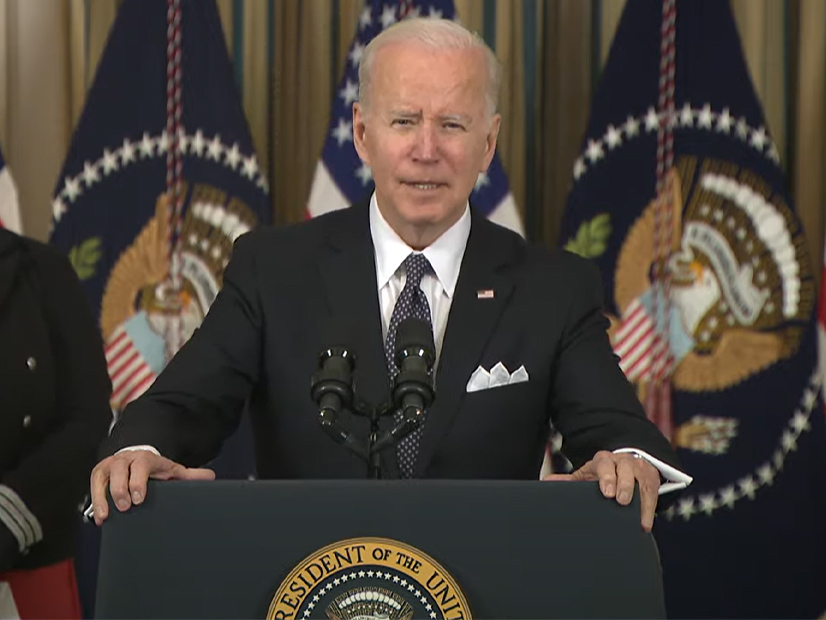
President Joe Biden’s $5.8 trillion federal budget request for 2023 contains a raft of line items aimed at cutting greenhouse gas emissions, advancing clean energy research and deployments, and propping up the nation’s energy security.
The budget rollout on Monday included announcements from the Department of Energy, the Environmental Protection Agency and the Bureau of Ocean Energy Management detailing the federal dollars for energy and climate projects that are included in their budget requests.
The tax credits and other incentives for clean energy development contained in the failed Build Back Better Bill are not specifically listed in the budget, but, according to a report from Bloomberg, will be included in a placeholder “deficit-neutral reserve fund.”
DOE
The DOE announced a $48.2 billion budget request for 2023 — a $2 billion increase over the $46.2 billion requested in 2022 — with significant clean energy investments but a strong focus on national security. Specifically, close to half of the 2023 budget, $21.4 billion, is earmarked for the National Nuclear Security Administration “to make necessary investments to maintain a safe, secure and effective nuclear weapons stockpile,” according to the DOE’s announcement.
The department is also asking for $202 million for the Office of Cybersecurity, Energy Security and Emergency Response to address cybersecurity risks.
On the energy side, the request focuses heavily on energy efficiency and clean energy research and development. “The investments reflected in this latest budget will cut costs for Americans and secure our energy independence on our path towards a net-zero future,” Energy Secretary Jennifer Granholm said in the announcement.
The budget request includes the following clean energy spending:
- $502 million to weatherize at least 50,000 homes, including $100 million to retrofit and decarbonize low-income households, installing energy-efficient appliances and systems to cut energy bills. Another $105 million in grants will go to states to help them create “more reliable and affordable clean energy systems.”
- $200 million “to bolster the U.S. supply chain for solar energy technologies through a new Solar Manufacturing Accelerator.” Another $18 million will go toward building international partnerships to “bolster secure supply chains and expand economic opportunities.”
- Other supply chain spending includes $5 billion for the Loan Programs Office for investments that will support domestic supply chains for critical minerals.
- $4 billion “to accelerate research, development, demonstration and deployment of technology and solutions to cut energy costs through low-cost clean energy resources.”
- Another $7.8 billion is slated to support research at the DOE’s national labs and at universities across the country “to accelerate novel technologies for clean energy solutions to mitigate climate change.”
EPA
EPA Administrator Michael Regan said the budget includes “historic investments” in support of the agency’s FY 2022-2026 Strategic Plan, “including tackling the climate crisis, advancing environmental justice, protecting air quality, upgrading the nation’s aging water infrastructure and rebuilding core functions at the agency.”
“For the first time, EPA’s final [Strategic] Plan includes a strategic goal focused exclusively on addressing climate change, as well as an unprecedented strategic goal to advance environmental justice and civil rights,” EPA said. “At the foundation of the plan is a renewed commitment to the three principles articulated by EPA’s first Administrator, William Ruckelshaus — follow the science, follow the law, and be transparent – while adding an additional fourth principle: advance justice and equity.”
In addition to $4 billion to upgrade drinking water and wastewater infrastructure, the plan includes:
- $1.1 billion to improve air quality, reduce localized pollution and exposure to radiation, and improve indoor air quality;
- $100 million in grants to tribes and states to support greenhouse gas reductions and increased resilience;
- $35 million to implement the American Innovation in Manufacturing Act to phase out hydrofluorocarbons, a greenhouse gas; and
- $13 million in wildfire prevention and readiness.
In support of Biden’s Justice40 commitment to ensure at least 40% of federal investments in climate and clean energy benefit historically overburdened and underserved communities, EPA would spend $1.45 billion to “create good-paying jobs, clean up pollution, advance racial equity and secure environmental justice,” Regan said. EPA has proposed creation of an environmental justice program office to oversee the effort.
To “rebuild the agency’s capacity” following cuts under the Trump administration, the spending plan would also fund more than 1,900 new full-time equivalents, boosting EPA’s staffing to more than 16,200 FTEs.
BOEM
The Interior Department’s Bureau of Ocean Energy Management would receive $237.4 million in funding, including $51.7 million for BOEM’s renewable energy program, which is supporting the administration’s goal of deploying 30 GW of offshore wind energy capacity by 2030.
BOEM’s conventional energy program, supporting oil and gas leasing, would receive $63.6 million, while its marine minerals program would get $15.4 million to help procure sand and sediment for coastal restoration.
The budget includes $86.4 million to fund BOEM’s environmental analyses.
BOEM plans to issue nine environmental reviews of offshore wind projects in FY 2023 and to hold up to three lease sales in FY 2022 and up to two lease sales in FY 2023.


